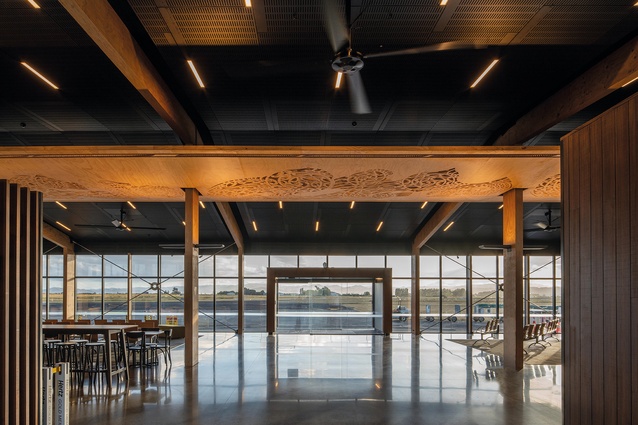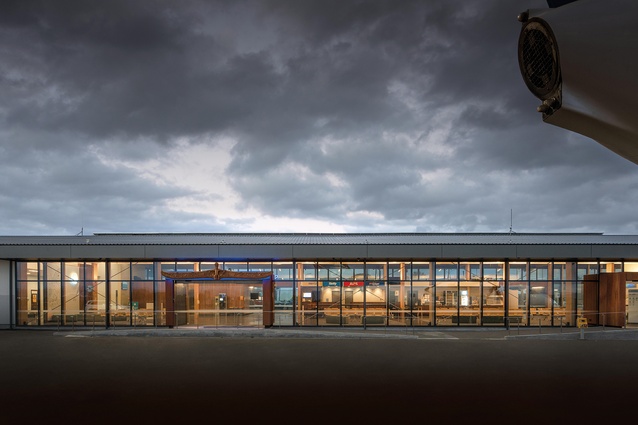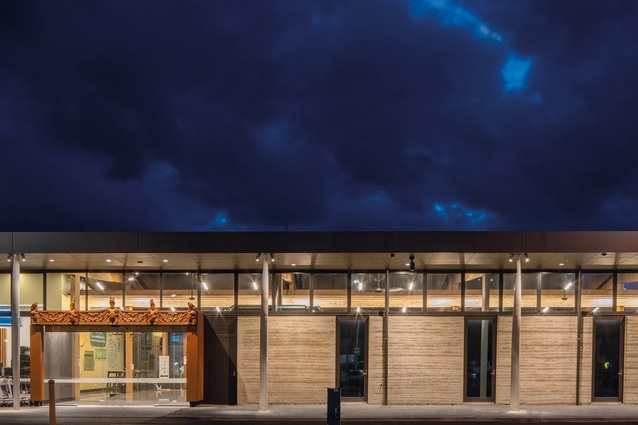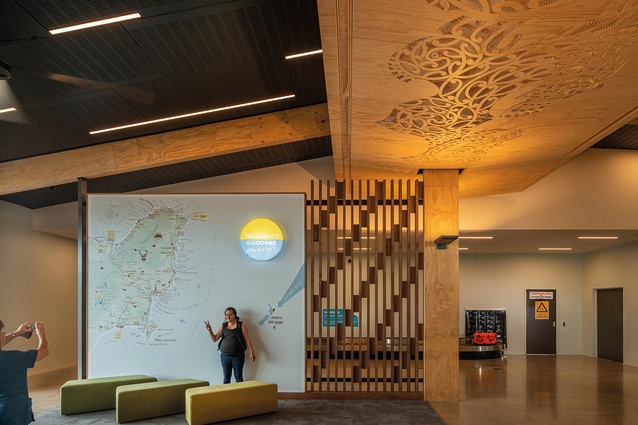He waewae pākura, from a solid footprint
Te Ari Prendergast contemplates the cultural intricacies of Tairāwhiti Gisborne Airport by Tennent Brown Architects in collaboration with Architects 44.
Ko Tūranga-a-Mua, Tūranga the ancient
Ko Tūranga Ararau, Tūranga the pathway of many
Ko Tūranga Makaurau, Tūranga of a thousand lovers
Ko Tūranga Tangata-rite, Tūranga the meeting place of people
Ko Tūranganui-a-Kiwa, the long waiting place of Kiwa
The story of arrival is engrained in the experience of Tūranganui-a-Kiwa (Poverty Bay). Kiwa, the high priest of the waka Horouta, gave Tūranga its name. Horouta was followed by the waka Nukutere and Tākitimu. Paikea then famously arrived on the back of a whale and, generations later, Captain James Cook arrived on the Endeavour. Indeed, the story of Aotearoa can be told through the shores of Tūranga. But, today, the story of arrival begins not by land or sea but by air. It is the architecture of Tairāwhiti Gisborne Airport and its role in welcoming visitors that continue this legacy of arrival.
The project, initially planned as a refurbishment but one which turned into a rebuild, began when regional infrastructure company Eastland Group approached local architect Dan King of Architects 44, who then connected with Ewan Brown and Hugh Tennent of Tennent Brown Architects in Wellington. Having worked on Wellington Airport, Brown says Tairāwhiti was relatively straightforward but still came with the challenge of keeping the airport operating while constructing a whole new building on the same site. His experience was invaluable, in terms of working through the issues on site as well as reducing the work to two stages.
Airports, by definition, are long, skinny buildings, each with an airside and a landside. The public function is in the centre; there’s baggage in and out, and the unseen operations. The architects designed ‘a simple shed’ in this case, with an upturned end like the waka tauihu and a downturned end like a whare bringing you home, connected by a long tāhuhu spanning the length of the building. In line with a strong sustainability focus, the tāhuhu also helped to integrate the building services designed by eCubed so the latter would not compete with the overall simplicity of the design.
A proactive client, Eastland Group introduced the design team to Karl Johnstone (Rongowhakaata) at the beginning of the project. Johnstone became a critical collaborator and link to all the local knowledge-holders and artists, ensuring the voices of manawhenua were heard and that their wishes were integrated into the design through the co-design process. “We saw this as an opportunity to create, collectively, a unique gateway to the region that tells the shared stories of Tairāwhiti,” says Brown, “and to be a strong vehicle for Rongowhakaata, for manawhenua, as the gateway experience for Gisborne and Te Tairāwhiti.” It was from that basis that the conversations began with Johnstone, who, as a designer himself, was an effective conduit between the design team and manawhenua artists, represented by master carver Tā Derek Lardelli and kaiako whakairo Tiopira Rauna.
To begin the project, a hui was called on the local Ngāi Tāwhiri marae with kaumātua and artists from Rongowhakaata. Kōrero began around conceptual ideas for the mahi toi and the ways in which these could be incorporated into the architecture of the new airport building. It was about a representation of manawhenua, the people of this land, mana moana, the people of the ocean and mana tāngata, the people of significance. “The first thing we always begin with from a Māori architecture perspective is ‘Te Ao Wairua’, the spiritual side, and anything we do is guided by that spiritual context,” explains Rauna. “In line with this, a karakia whakawātea was performed to bless the site with the planting of a rākau, to have a spiritual connection to the project through to the completion.”
The artists reviewed the initial architecture plans, with Rauna working on the kei āhau te mahau o te whare (exterior) and Lardelli on the kei a koe te poho o te whare (interior). “It was about marrying those concepts together through the context of contemporary toi Māori,” says Rauna. “We saw this initial engagement as ‘he waewae pākura’, a solid footprint, whereby we were resourced to do the work and engaged early on so we could contribute to our fullest abilities.”
There was much discussion about how a visitor landed and was supported by the airport. The pare have a wonderful story about the kuia and their relationship with welcome. As the modern embodiment of welcome, the two pare at each entrance acknowledge key tūpuna kuia that connect to the hapū of the area, and the role kai kāranga play in the welcoming of visitors.
Where the interior holds the mana of Ngāi Tāwhiri, the exterior reflects the manawhenua of Te Aitanga a Māhaki, Ngāi Tāmanuhiri and Ngāti Oneone, as well as Ngāti Porou, paying homage to all those iwi of Te Tairāwhiti. “We say of te ao wairua that they don’t sleep,” says Rauna, “so the kuia are doing the karanga, ‘ao noa, pō noa’, 24/7.”
Rauna explains that both exterior pare represent Rongowhakaata, Te Aitanga a Māhaki, Ngai Tāmanuhiri and Ngāti Oneone with our relationships to Te Tairāwhiti.
The landside pare is named ‘Ngā Tararere kārangaranga a Hine Hakirirangi’, the progeny of Hine Hakirirangi. The kuia in the middle is Hakirirangi, “our tūpuna wāhine who arrived on the Horouta waka”. On both sides are two wāhine: to her left are Rawinia Te Kani, kai kāranga at Te Poho-o-Rawiri marae and Riria Puehu, a matriarch of Ngāi Tāwhiri; to her right are Riperata Kahutia, who gifted the land the airport is on, and Waioeka Brown of Te Aitanga a Māhaki, who embodied these values of welcome to all, no matter who they are or where they are from. The three kuia based in the middle of the pare hold the manawhenua for Ngāi Tāwhiri of Rongowhakaata. “This pare is a representation of our mana-atua (spiritual connection), mana-tipua (guardian connection), mana-moana (seaward connection) and mana-whenua (land connection).”
On the airside, the pare is named ‘Te Waerea o Ruakapanga’, the incantation of Ruakapanga. “He is conducting a prayer of welcome to lift the tapu of their travels,” explains Rauna. “This pare is a representation of ngā manu nui a Ruakapanga, the prized birds of Ruakapanga. His two manu were called Harongarangi and Tiungarangi. The pare represents our connection to Ranginui and how our ancestors arrived here on birds.”
Inside, the concept of the manaia runs along the tāhuhu, traditionally the main structure of the whare. As a contemporary spin on the traditional tāhuhu, Wellington-based Makers of Architecture helped create the tāhuhu using a CNC machine to ‘carve’ the manaia, supervised by Lardelli. These manaia, again, reflect the different iwi and hapū of Rongowhakaata and those tūpuna who have paved the way for us, which, in a spiritual sense, is the meeting of the old world and the new. This is where the value of having those early conversations with the design team and marrying together these stories of tūpuna with the architectural concepts is so important.
The rammed-earth wall to the landside of the building continues this connection to the land and also harks to the primary industries that have built the local economy. Rammed earth is a local material, from papatūānuku: a grounded, solid anchoring and also a sustainable material with relatively low carbon. The texture of the rammed-earth wall helps to bring nature into the building. The twisted columns speak of propellers but also turn towards Te Kurī-a-Pāoa, a nod to the landscape. The simple, darkened ceiling helps to emphasise the interior features, such as the tāhuhu. The manaia on the tāhuhu breaks what otherwise might have been a commercial feel and enhances the wairua of those who work within and facilitates the human aspects of manaakitanga. The building’s large open spaces are regularly used by schools and other groups for events, and this provides a connection to the local community. As well as performing a cultural function, the materials selected are non-toxic and were chosen to help reduce the carbon impact of the building. Throughout the project, there is a synergy of combining the narratives to the landscape in the artworks and materiality, coupled with the sustainable design aspects. As Tennent says, “If you make it beautiful and great to be in, and it’s telling a story, then it can be more than just a place to get a ticket.” King adds, “then it feels authentic; it feels of its place.”
Here, the concept of kaitiakitanga has found synchronicity with contemporary sustainability. As well as this being the ‘most Māori’ airport in Aotearoa, there was a desire, also, for it to be the ‘most sustainable’ and an attempt to be the first Living Building Challenge (LBC) airport. Tennent Brown had previously worked on two projects using the LBC as a sustainability driver. Eastland Group was interested in this, and the architects offered to carry out materials research to see if they could achieve this level of performance. LBC requires a building to generate 10 per cent of its power needs, be water self-sufficient on its site, do a full life-cycle analysis (LCA) and minimise carbon and offset the remainder as well as select non-red-list chemicals for everything within the building. They managed this very challenging process to detail, specify and tender but, in the end, they had to value-manage some items out to maintain budget. Unfortunate, but it provided a great learning curve that has enabled other LBC initiatives on site; there are plans to build a large photovoltaic array and the opportunity for LBC zero-energy certification in the future.
For Māori, the culmination of the architecture process is the opening ceremony where the building is made safe from the tapu of its creation. The success of the opening ceremony is indicative of a well-run process and, while the rest of the world was ‘closing’ amongst the challenges of Covid-19, Tairāwhiti still “opened an airport”.
It is said of Pritzker Architecture Prize recipient Francis Kéré that his architecture is “not about the object but the objective; not the product, but the process”.1 This project, like in the work of Kéré, has elevated the process and purpose of architecture through the connection with manawhenua, mana moana and mana tāngata, and, as a result, the architecture is thus the embodiment of the experience of arrival and welcome.
1 Jury citation, 2020, pritzkerprize.com/laureates/diebedo-francis-kere
















